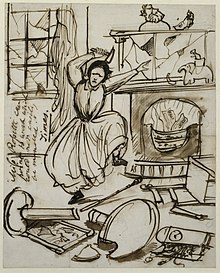
A tantrum, angry outburst, temper tantrum, lash out, meltdown, fit, or hissy fit is an emotional outburst,[1][2][3] usually associated with those in emotional distress. It is typically characterized by stubbornness, crying, screaming, violence,[4] defiance,[5] angry ranting, a resistance to attempts at pacification, and, in some cases, hitting and other physically violent behavior. Physical control may be lost; the person may be unable to remain still; and even if the "goal" of the person is met, they may not be calmed. Throwing a temper tantrum can lead to a child getting detention or being suspended from school for older school age children, and can result in a timeout or grounding, complete with room or corner time, at home.[6][7][8][9][10][11] A tantrum may be expressed in a tirade: a protracted, angry speech.[6][7][12]
- ^ Album, Cabinet (1830). "The Cabinet Album A Collection of Original and Selected Literature". The. Hurst, Chance and Company: 92.
- ^ Foote, Samuel (1765). "The Dramatic Works Volume 1". The Dramatic Works. 1. P. Vaillant: 40–41.
- ^ Payn, James (1869). Married Beneath Him. A novel. By the author of "Lost Sir Massingberd" James Payn. The British Library. p. 369.
- ^ O'Hara, Kane (1770). "Midas An English Burletta. As it is Performed at the Theatre-Royal, in Covent-Garden". Midas an English Burletta. As It is Performed at the Theatre-Royal, in Covent-Garden: 20.
- ^ GOMBERT, A. J. (1825). "The French Drama ... with Notes Critical and Explanatory, by A. G. Volume 2 of The French Drama ... with Notes Critical and Explanatory, by A. G". The French Drama... 2. The British Library: 47.
- ^ a b Penelope Leach. "What is a tantrum?". BabyCentre. Retrieved 2011-03-20.
- ^ a b "Temper Tantrums". KidsHealth. Retrieved 2011-03-20.
- ^ Karisa Ding (July 26, 2017). "Tantrums". BabyCenter. Retrieved 2011-03-20.
- ^ Jan Hunt. "When a Child Has a Tantrum". The Natural Child Project. Retrieved 2011-03-20.
- ^ Mullen, J.K. (1983). "Understanding and managing the temper tantrum". Child Care Quarterly. 12 (1): 59–70. doi:10.1007/BF01258080. S2CID 144110786.
- ^ Geelerd, E.R. (1945). "Observations on temper tantrums in children". American Journal of Orthopsychiatry. 15 (2): 238–246. doi:10.1111/j.1939-0025.1945.tb04937.x.
- ^ Daniels, Elizabeth; Mandleco, Barbara; Luthy, Karlen E. (2012). "Assessment, management, and prevention of childhood temper tantrums". Journal of the American Academy of Nurse Practitioners. 24 (10): 569–573. doi:10.1111/j.1745-7599.2012.00755.x. PMID 23006014.